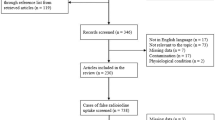Abstract
Objective
We assessed the performance of 37 MBq I-123 as a diagnostic imaging agent in patients with differentiated thyroid cancer using comparisons with their corresponding high-dose post-treatment I-131 scans.
Methods
We reviewed diagnostic I-123 whole-body scans and post-treatment I-131 scans of 69 patients who underwent I-131 therapy for differentiated thyroid carcinoma (47 papillary and 22 follicular). Diagnostic scans were performed 24 h following the oral administration of 37 MBq of I-123. I-131 doses were administered 3 days after the I-123 diagnostic scans using 2.22–7.4 GBq (median = 5.55 GBq). All images for diagnostic I-123 scans and the corresponding post-treatment I-131 scans were interpreted by consensus of at least 2 experienced radiologists. They evaluated the accumulations of radioiodine in the following 5 sites: thyroid bed, cervical and mediastinal lymph nodes, lung, bone and others. The concordance rates between I-123 scans and I-131 scans were calculated.
Results
A total of 108 sites were identified on the post-treatment I-131 scans. Seventy-seven sites (71%) were also identified on the I-123 diagnostic scans. The concordance rates between I-123 diagnostic scans and I-131 post-treatment scans were high for thyroid bed and bone metastases (89 and 86%, respectively), while they were low for lymph node and lung metastases on post-treatment scans (61 and 39%, respectively).
Conclusions
Diagnostic scanning with relatively low dose I-123 is not always predictive of subsequent therapeutic I-131 uptake, especially for lymph node and lung metastases of differentiated thyroid cancer.



Similar content being viewed by others
References
Sarkar SD, Kalapparambath TP, Palestro CJ. Comparison of (123)I and (131)I for whole-body imaging in thyroid cancer. J Nucl Med. 2002;43:632–4.
Silberstein EB. Comparison of outcomes after (123)I versus (131)I pre-ablation imaging before radioiodine ablation in differentiated thyroid carcinoma. J Nucl Med. 2007;48:1043–6.
Mandel SJ, Shankar LK, Benard F, Yamamoto A, Alavi A. Superiority of iodine-123 compared with iodine-131 scanning for thyroid remnants in patients with differentiated thyroid cancer. Clin Nucl Med. 2001;26:6–9.
Tachi Y, Iwano S, Kato K, Tadokoro M, Naganawa S. Diagnostic whole-body scanning before radioiodine therapy for pulmonary metastases of differentiated thyroid cancer: predictive value and recommendations. Clin Nucl Med. 2008;33:845–51.
Park HM, Park YH, Zhou XH. Detection of thyroid remnant/metastasis without stunning: an ongoing dilemma. Thyroid. 1997;7:277–80.
Park HM, Perkins OW, Edmondson JW, Schnute RB, Manatunga A. Influence of diagnostic radioiodines on the uptake of ablative dose of iodine-131. Thyroid. 1994;4:49–54.
Yaakob W, Gordon L, Spicer KM, Nitke SJ. The usefulness of iodine-123 whole-body scans in evaluating thyroid carcinoma and metastases. J Nucl Med Technol. 1999;27:279–81.
Siddiqi A, Foley RR, Britton KE, Sibtain A, Plowman PN, Grossman AB, et al. The role of 123I-diagnostic imaging in the follow-up of patients with differentiated thyroid carcinoma as compared to 131I-scanning: avoidance of negative therapeutic uptake due to stunning. Clin Endocrinol (Oxf). 2001;55:515–21.
Alzahrani AS, Bakheet S, Al Mandil M, Al-Hajjaj A, Almahfouz A, Al Haj A. 123I isotope as a diagnostic agent in the follow-up of patients with differentiated thyroid cancer: comparison with post 131I therapy whole body scanning. J Clin Endocrinol Metab. 2001;86:5294–300.
Gerard SK, Cavalieri RR. I-123 diagnostic thyroid tumor whole-body scanning with imaging at 6, 24, and 48 hours. Clin Nucl Med. 2002;27:1–8.
Ali N, Sebastian C, Foley RR, Murray I, Canizales AL, Jenkins PJ, et al. The management of differentiated thyroid cancer using 123I for imaging to assess the need for 131I therapy. Nucl Med Commun. 2006;27:165–9.
Cohen JB, Kalinyak JE, McDougall IR. Clinical implications of the differences between diagnostic I-123 and post-therapy 131I scans. Nucl Med Commun. 2004;25:129–34.
Donahue KP, Shah NP, Lee SL, Oates ME. Initial staging of differentiated thyroid carcinoma: continued utility of posttherapy 131I whole-body scintigraphy. Radiology. 2008;246:887–94.
Shankar LK, Yamamoto AJ, Alavi A, Mandel SJ. Comparison of 123I scintigraphy at 5 and 24 hours in patients with differentiated thyroid cancer. J Nucl Med. 2002;43:72–6.
Urhan M, Dadparvar S, Mavi A, Houseni M, Chamroonrat W, Alavi A, et al. Iodine-123 as a diagnostic imaging agent in differentiated thyroid carcinoma: a comparison with iodine-131 post-treatment scanning and serum thyroglobulin measurement. Eur J Nucl Med Mol Imaging. 2007;34:1012–7.
Durante C, Haddy N, Baudin E, Leboulleux S, Hartl D, Travagli JP, et al. Long-term outcome of 444 patients with distant metastases from papillary and follicular thyroid carcinoma: benefits and limits of radioiodine therapy. J Clin Endocrinol Metab. 2006;91:2892–9.
Schlumberger MJ. Papillary and follicular thyroid carcinoma. N Engl J Med. 1998;338:297–306.
de Geus-Oei LF, Oei HY, Hennemann G, Krenning EP. Sensitivity of 123I whole-body scan and thyroglobulin in the detection of metastases or recurrent differentiated thyroid cancer. Eur J Nucl Med Mol Imaging. 2002;29:768–74.
Hinds SR 2nd, Stack AL, Stocker DJ. Low-iodine diet revisited: importance in nuclear medicine imaging and management. Clin Nucl Med. 2008;33:247–50.
Sanchez R, Espinosa de los Monteros AL, Mendoza V, Brea E, Hernandez I, Sosa E, et al. Adequate thyroid-stimulating hormone levels after levothyroxine discontinuation in the follow-up of patients with well-differentiated thyroid carcinoma. Arch Med Res. 2002;33:478–81.
Anderson GS, Fish S, Nakhoda K, Zhuang H, Alavi A, Mandel SJ. Comparison of I-123 and I-131 for whole-body imaging after stimulation by recombinant human thyrotropin: a preliminary report. Clin Nucl Med. 2003;28:93–6.
Yan W, Roach PJ, Bautovich GJ, Learoyd DL, Robinson BG. Timing of iodine-123 scintigraphy following use of recombinant human thyrotropin in differentiated thyroid carcinoma. Clin Nucl Med. 2007;32:375–7.
Acknowledgments
Any financial support for this study was not provided.
Author information
Authors and Affiliations
Corresponding author
Rights and permissions
About this article
Cite this article
Iwano, S., Kato, K., Nihashi, T. et al. Comparisons of I-123 diagnostic and I-131 post-treatment scans for detecting residual thyroid tissue and metastases of differentiated thyroid cancer. Ann Nucl Med 23, 777–782 (2009). https://doi.org/10.1007/s12149-009-0303-z
Received:
Accepted:
Published:
Issue Date:
DOI: https://doi.org/10.1007/s12149-009-0303-z




